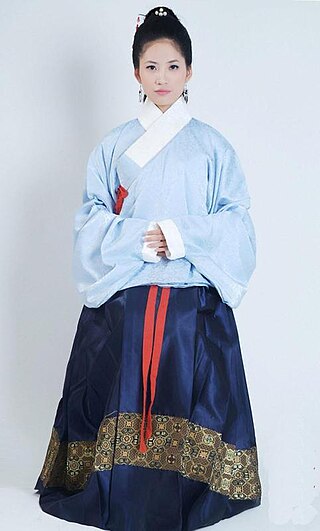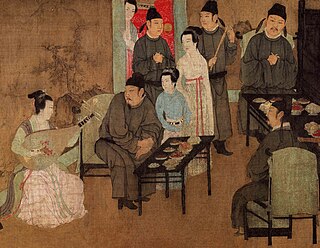
Cheongsam or zansae, also known as the qipao and sometimes referred to as the mandarin gown, is a Chinese dress worn by women which takes inspiration from the qizhuang, the ethnic clothing of the Manchu people. The cheongsam is most often seen as a longer, figure-fitting, one piece garment with a standing collar, an asymmetric, left-over-right opening and two side slits, and embellished with Chinese frog fasteners on the lapel and the collar. It was developed in the 1920s and evolved in shapes and design over years. It was popular in China from the 1920s to 1960s, overlapping with the Republican era, and was popularized by Chinese socialites and high society women in Shanghai. Although the cheongsam is sometimes seen as traditional Chinese clothing, the cheongsam continues to evolve with times as it responds to the contemporary modern life.

Changshan, also known as changpao, and dagua, is a form of paofu, Chinese robe, which was derived from the Qing dynasty qizhuang, the traditional dress of the Manchu people, which were worn by Manchu men. The changshan was actually developed by the Han Chinese through the modification of their own Ming dynasty's Hanfu by adopting some Manchu men's clothing elements in one of their Hanfuchangshan. In function, the changshan is considered the male equivalent of the women's cheongsam. The changshan was often worn by men with a magua, also commonly translated as "riding jacket" in English language.

The modern Chinese tunic suit is a style of male attire originally known in China as the Zhongshan suit after the republican leader Sun Yat-sen. Sun Yat-sen introduced the style shortly after the founding of the Republic of China (1912–1949) as a form of national dress with distinct political overtones. The four pockets are said to represent the Four Virtues of propriety, justice, honesty, and shame; and the five buttons the branches of China's former government, which still survive today in the Republic of China government of Taiwan.

A pankou is a type of ornamental braiding closure made out of cord, consisting of a button and a loop; it is used to fasten garments without creating an overlap. Its purpose is to act as a fastener as well as providing a decorative closure for the garment. It is especially used on the cheongsam, where the frog represents the cultural essence of the dress.

Sherwani is a long-sleeved outer coat worn by men in South Asia. Like the Western frock coat, it is fitted, with some waist suppression; it falls to below the knees and is buttoned down the front. It can be collarless, have a shirt-style collar, or a stand-up collar in the style of the Mandarin collar. It evolved in the Indian subcontinent in the 19th-century as a result of the outer garment of the late Mughal period, the angarkha—itself evolved from the Persian cape, balaba—being given a western style with a button-down front.

Vietnamese clothing is the traditional style of clothing worn in Vietnam by the Vietnamese people. The traditional style has both indigenous and foreign elements due to the diverse cultural exchanges during the history of Vietnam. This all eventually led to the birth of a distinctive Vietnamese style of clothing, including the birth of the unofficial national dress of Vietnam, the áo dài.

Tangzhuang, sometimes called Tang suit, is a kind of Chinese jacket with Manchu origins and Han influences, characterized with a mandarin collar closing at the front with frog buttons. It is an updated form of the Qing magua, itself a more fashionable adaptation of the riding jacket once worn by Manchu horsemen. Nowadays, the tangzhuang is one of the main formal clothing worn by Chinese men on various occasions; overseas Chinese also wear it as a form of fashion or to express their cultural identity.

Chinese clothing includes the traditional hanfu and garments of ethnic minorities, as well as modern variations of indigenous Chinese dresses. Chinese clothing has been shaped through its dynastic traditions, as well as through foreign influences. Chinese clothing showcases the traditional fashion sensibilities of Chinese culture traditions and forms one of the major cultural facets of Chinese civilization.
Each branch of the Confederate States armed forces had its own service dress and fatigue uniforms and regulations regarding them during the American Civil War, which lasted from April 12, 1861, until May 1865.

Ruqun is a set of attire in Hanfu which consists of a short jacket typically called ru worn under a long Chinese skirt called qun. However, when use as a general term, ruqun can broadly describe a set of attire which consists of a separated upper garment and a wrap-around lower skirt, or yichang, in which yi means the "upper garment" and the chang means the "lower garment". In a broad sense, ruqun can include the shanqun and aoqun in its definition.

Chang-ao, lit. translated as "long jacket" or "long ao", is a historical long-length, Chinese upper garment called ao (袄), which was worn by women. It is also known as da ao (大袄) and chang ru which appears to be the precursor of the ao.
Banbi, also known as banxiu and sometimes referred as beizi or half-beizi before the term beizi eventually came to refer to a long-sleeved beizi in the Song dynasty, and referred as dahu in the Yuan dynasty, is an upper garment item in Hanfu. The banbi is in the form of a waistcoat or outerwear with short sleeves, which could either be worn over or under a long-sleeved ruqun. The style of its collar varies; it can also be secured at the front either with ties or a metal button.
A yuanlingshan is a type of round-collared upper garment in the traditional Chinese style of clothing known as Hanfu; it is also referred to as a yuanlingpao or a panlingpao when used as a robe. The yuanlingshan and yuanlingpao were both developed under the influence of ancient Chinese clothing, known as Hufu, originating from the Donghu people during the early Han dynasty and later by the Wuhu, including the Xianbei people, during the Six Dynasties period. The yuanlingpao is an article of formal attire primarily worn by men, although in certain dynasties, such as the Tang dynasty, it was also fashionable for women to wear. In the Tang dynasty, the yuanlingpao could be transformed into the fanlingpao using buttons.

Raj pattern refers either to a Thai men's costume consisting of a white Nehru-style jacket with five buttons, a chong kraben, knee-length socks and dress shoes, or to the specific form of the jacket itself. It was worn chiefly during the late nineteenth and early twentieth centuries by government officials and the upper class in Bangkok, and nowadays is used in select circumstances as a national costume.

Hanfu are the traditional styles of clothing worn by the Han Chinese. There are several representative styles of hanfu, such as the ruqun, the aoqun, the beizi and the shenyi, and the shanku.

Shanku is a generic term which refers to a two-piece set of attire in Hanfu, which is typically composed of a youren yi, a Chinese upper garment which typically overlaps and closes on the right side which could be called shan, ru, ao, and a pair of long trousers ku. As a form of daily attire, the shanku was mainly worn by people from lower social status in China, such as labourers, shopkeepers, or retainers from wealthy household. The shanku was originally worn by both genders. Up until the mid-20th century, it was popular in China and outside of China where it was worn by overseas Chinese in countries, such as Singapore, Malaysia, Suriname, etc. It is still worn in present-day China and can be found in rural areas.

Ru, sometimes referred to as shan, ao, and yi, is a form of traditional Chinese upper garment, or coat, or jacket, which typically has a right closure; however, they may also have a front central opening. It is traditional everyday wear for women of the Han Chinese ethnic group. It can be worn in combination with a skirt in a style called ruqun, or a pair of trousers in a style called shanku.

Yajin, also known as shijian er, is a type of Chinese accessory which is placed at the lapels of Chinese clothing ; they would typically hanged down on the right side of the chest area in order to press on the clothing. The yajin appeared as early as the Tang dynasty and became popular in the Ming and Qing dynasties. There are various styles of yajin, including a dangling pendant-style and a bracelet-style, known as shibazi. Yajin can also be used as accessories on the cheongsam, where it is tied on the pankou knots.

Qizhuang, also known as Manfu and commonly referred as Manchu clothing in English, is the traditional clothing of the Manchu people. Qizhuang in the broad sense refers to the clothing system of the Manchu people, which includes their whole system of attire used for different occasions with varying degrees of formality. The term qizhuang can also be used to refer to a type of informal dress worn by Manchu women known as chenyi, which is a one-piece long robe with no slits on either sides. In the Manchu tradition, the outerwear of both men and women includes a full-length robe with a jacket or a vest while short coats and trousers are worn as inner garments.

Garment collars in hanfu are diverse and come in several shapes, including jiaoling, duijin, yuanling, liling, fangling, tanling. Some forms of collars were indigenous to China while others had been adopted from the Hufu of other non-Han Chinese ethnic minorities and/or from the clothing worn by foreigners.


























